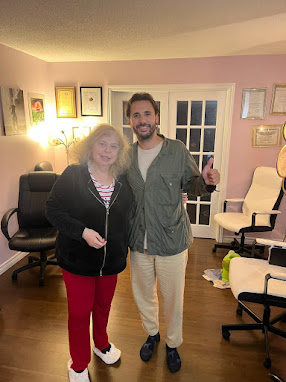Voice Repair: We Don’t Just Speak About It - We Make It Happen!
I have been teaching and repairing voices for many years now. I have taught actors, professional media personnel, voice-over speakers, fitness instructors, and, of course, singers of all calibers. To survive in those described above professions, you need a strong voice, a voice which will never let down its user.
Those people’s
livelihood directly depends on the strength, health and command of their
voices. If the
person, of any of the described above professions, would damage and/or lose their voice, their livelihood would be (very much so) in jeopardy.
Over the
years, I’ve fixed the voices of quite well-known radio and TV personnel, public
speakers, pastors, worship leaders, to name a few. All of them
needed their voice back to the normal operational state and as soon as
possible! So there was
no time to just speak about it or feed them with promises of a future recovery —
I had to get to the action and to act upon it immediately!
These people
were desperate, as they were literally losing their jobs along with their passion and
zest for life. Some of them
just had to restore their speaking voice; some - their singing voice; but others
had to restore both. I cannot
describe the emotional, physical, and mental impact the damaged voice had on
those sufferers.
The voice is our main tool for communication.
It reflects
on the state of our being and actually identifies who we are. When the
voice is damaged, the in-congruency between who that person is in reality and
what he/she is able to express, makes the whole matter devastating. The voice
sufferer ultimately loses his/her (known-to-them) identity. When the
voice damage occurs, the surrounding people now have difficulty to assess the
person in front of them due to verbal communication breakdown. The person
with the voice problem becomes (understandably) less communicative due to the
difficulty of speech and constant tiredness of their voice.
When those people happen to be in a loud environment, they nearly become mute, as they
intuitively feel that if they tried to speak and (on top of it) with more volume, they might actually push their voice to the max (possibly) the last time; and thus, lose whatever has been left (at all) of their sound. So, in not
so many words, it is a real tragedy and practical help MUST be administered immediately.
A lot of
voice practitioners, speech therapists, vocal coaches like to theorize about
it, but the clock is ticking and every day counts, especially for those
who have to return back to their everyday lives, not to mention, their speaking
and/or singing career. Now voice repair
– hands-on-experience should take place.
Majority of
people, especially with growth(s) on their vocal cords like nodules, polyps,
lesions etc., luckily do not want to, right away, jump onto the operating table. They are
usually looking for alternative ways to solve their voice/vocal problems.
Now, I – the
non-surgical voice repair specialist – have to go into action, along with my
client, as it “takes two to tango”, so to speak. Both of us,
my voice repair client and I, are facing a very intense and detailed (syllable-on-syllable, vowel-on-vowel, word-on-word) instruction.
The first thing to do is to fix the speaking voice (this applies to both speakers and singers); and then teach both (a speaker and a singer) how to apply a new technique for their speaking voice.
Then, respectively, teach a singer how to sing a new way – not pushing the sound of their voice down to their throat by virtue of dropping the jaw almost down to the knee, and also not simultaneously sticking the stomach out and pelvis forward.
The first thing to do is to fix the speaking voice (this applies to both speakers and singers); and then teach both (a speaker and a singer) how to apply a new technique for their speaking voice.
Then, respectively, teach a singer how to sing a new way – not pushing the sound of their voice down to their throat by virtue of dropping the jaw almost down to the knee, and also not simultaneously sticking the stomach out and pelvis forward.
In order to recover
the voice, the speaking and singing voice application has to change completely. To
accomplish this, I have to practically use a “Pavlovian conditioning” method
and virtually re-teach the psyche and the human anatomy a completely different behavior, which also falls in the science of neural-linguistic programming
(NLP).
So it is a
complex endeavor and it cannot be treated lightly (furthermore, remotly).
There is
indeed no time to just speak about it; there is a lot of mental, physical,
emotional and vocal work to be done, and, nevertheless, in practice and not just in theory.




